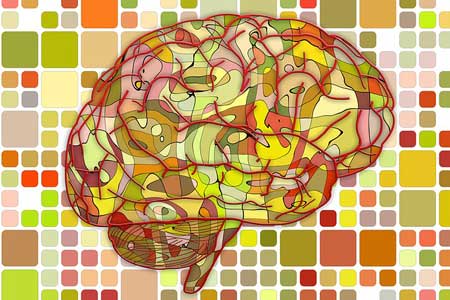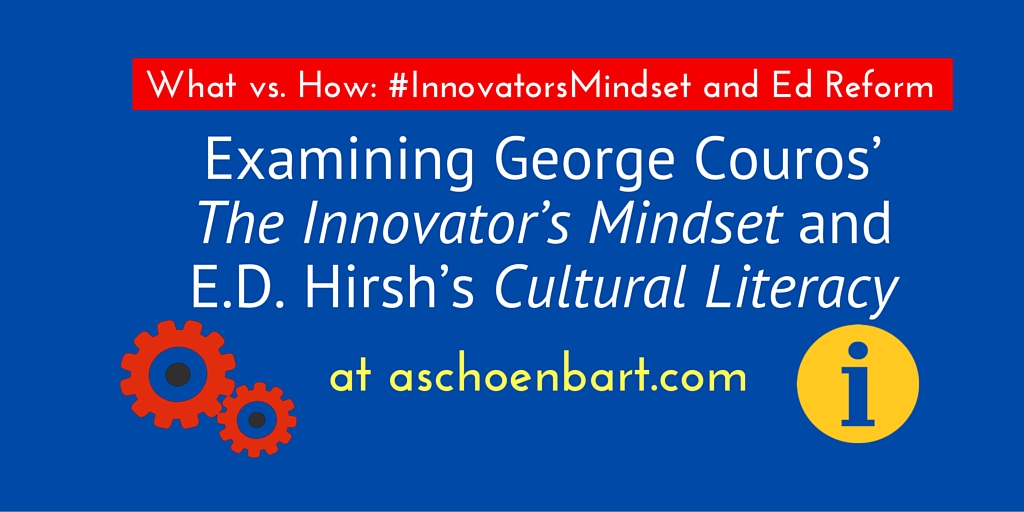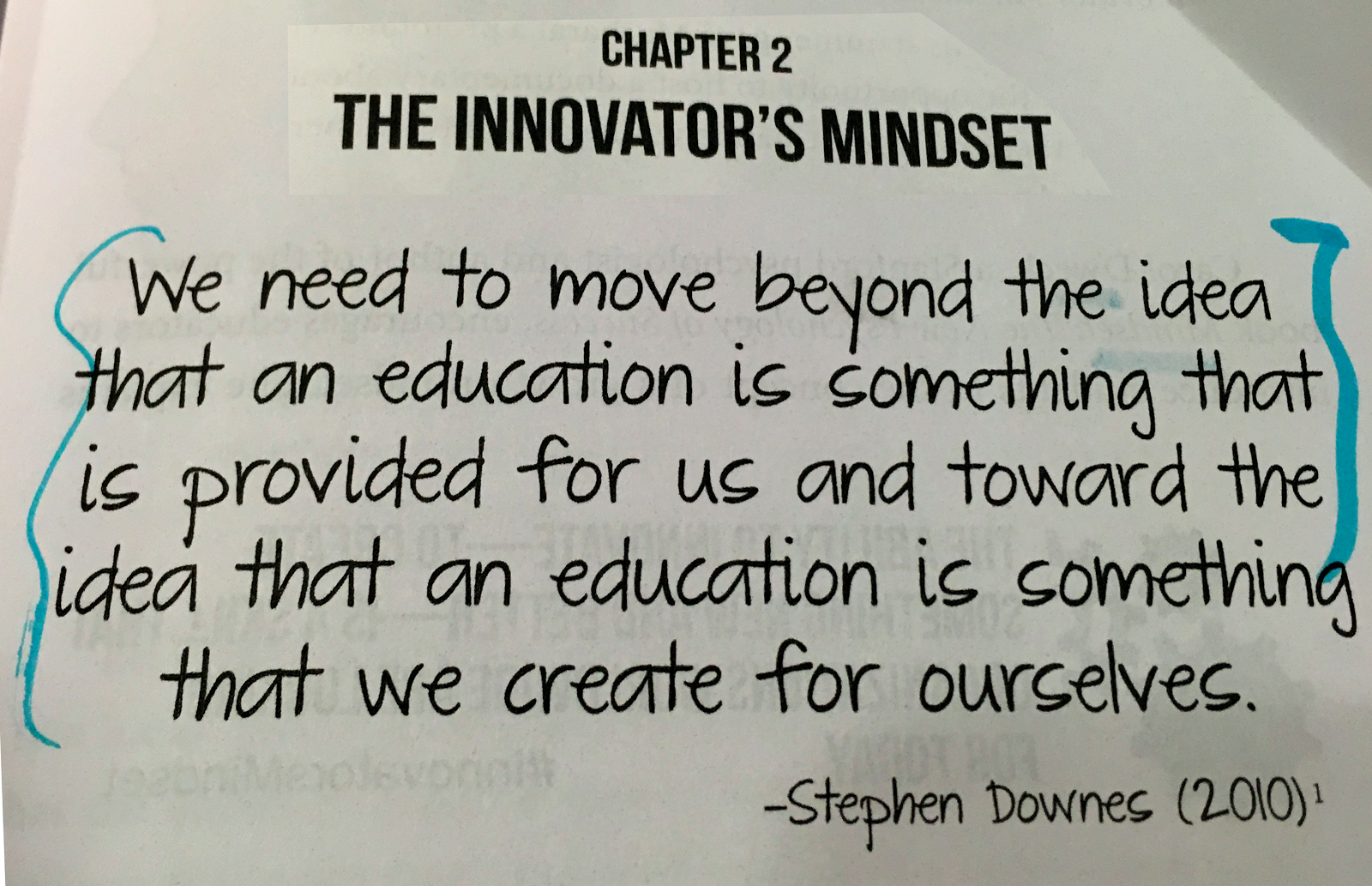What vs. How: #InnovatorsMindset and Ed Reform


For a summer doctoral class titled Culture, Politics, and Educational Reform, I was assigned a paper on an educational controversy. I was directed to read two books that offer different viewpoints on an issue, and to analyze both arguments through the lens of educational change. I was already reading George Couros’The Innovator’s Mindset, which advocates for a shift in mindset to innovation and risk-taking in education, and my professor suggested I pair it with E.D. Hirsh’s classic, Cultural Literacy. In it, Hirsh argues that there a specific and concrete list of facts and information that every literate American needs to know.
I really enjoyed the reading and analysis, and think the combination of the texts offer a really interesting lens for examining today’s world of education. In June, I set out to plan My Summer of Learning, and The Innovator’s Mindset was at the top of the list (full disclosure: I’ve only read Innovator's and half of Teach Like a Pirate so far, and haveHacking Assessment on deck--dissertation reading has taken over!).
The paper presented both author’s arguments, essentially contrasting changes in how we should be learning (Couros) versus what we should be learning (Hirsh). It should be no surprise that I connected more with #InnovatorsMindset; in fact, I found some of Hirsh’s arguments to be laughable and even offensive from a modern perspective. If you are interested in the full paper, read it here, but for this post I will stick to some of the highlights examining these two viewpoints on educational reform. This writing is more scholarly than my usual work--it is excerpted from my coursework, after all, but I think it will still be meaningful to my audience.
#InnovatorsMindset In The Innovator’s Mindset, Corous uses his own experiences as a teacher, administrator, and lead learner to make an argument for a shift in how we view education. He builds on the concept of Carol Dweck’s growth mindset, positing that today’s students need something more; they need the innovator’s mindset: “the belief that the abilities, intelligence, and talents are developed so that they lead to the creation of new and better ideas . . . We must focus on creating something with the knowledge that’s been acquired” (2015, p. 33). Innovation is not about technology, but about new and improved ways of thinking about learning. He describes eight characteristics of the innovator’s mindset as empathetic, problem finders/solvers, risk takers, networked, observant, creators, resilient, reflective.
Couros makes the compelling argument that today’s schools are largely becoming outdated in the wake of worldwide change. Because students’ futures, jobs and careers, post-secondary education, and the world economy all predict such drastic change, our systems need change, too. We cannot keep preparing students for the world of yesterday, or even of today. He writes, “I’m not saying that today’s schools are irrelevant yet . . . We need to change what school looks like for our students so we can create new, relevant opportunities for them--for their future and for today” (p. 5). Education needs to “create the conditions where change is more likely to happen” (p. 8).
What Americans Need to Know
For Hirsh, however, skill is never really an issue. He briefly addresses it throughout Cultural Literacy, but almost half of the text is his master list of what every American needs to know; “To be culturally literature is to possess the basic information needed to thrive in the modern world” (p. xiii). His influences come from schema theory, as he argues that knowledge, information, and how we make connections between information is the most powerful factor in improving literacy. Like Couros, Hirsh’s work is a clear product of its time, referencing countless studies about the failing American education system of the 1980’s.
Hirsh’s ideas are a direct contradiction to much of the work that founded American education systems, like that of Dewey and Rousseau. They opposed such a focus on acquiring knowledge. Hirsh argues that Dewey had too much faith in students abilities to develop skills from knowledge (that sounds pretty crazy, right?). Instead, he advocates: “Only by piling up specific, communally shared information can children learn to participate in complex cooperative activities with other members of their community” (xv). He rejects formalistic education theories, which support that any suitable content can help develop skills. Instead, skills must be developed through the memorization of a standardized set of information--names, places, and ideas--and this can help to close achievement gaps and improve American society. He posits that “the decline of literacy and the decline of shared knowledge are closely related, interdependent facts” (p. 7).
Tools and ideas to transform education. Sign up below.

Conclusions
It’s difficult to examine these texts through the lens of educational change without the socio-historical frame. These texts both make sense in the times they were written. For Hirsh, a consistent curriculum was lacking (an issue we are still dealing with today) and knowledge reigned supreme.
He looked to information as the key to closing the achievement gap but clearly overlooked and outright ignored the value and development of skills, experience, and context. Some might argue that Couros may over rely on skills--what subject or information should teach resilience, for example?--and his open views to education and curriculum would likely infuriate Hirsh. But in today’s digital age, Hirsh can only be viewed as outdated, and at times offensive. Couros wants to engage and empower teachers and students and learners while Hirsh wants to dictate and limit learning experiences.
Next Time
Next week, I’ll share part 2 of the paper, where I contrast the two texts and their views on information and preparing students for their futures. I know this kind of post is a little different than my usual, but I think the themes of the texts and the lens of educational change are important for us all. Let me know in the comments or on Twitter if you agree.
What are your thoughts on #InnovatorsMindset? How does it compare to Hirsh’s views in Cultural Literacy? How do we balance content and skills in today’s classroom?
cross posted at www.aschoenbart.com
Adam Schoenbart is a high school English teacher, Google Education Trainer, and EdD candidate in Educational Leadership. He teaches grades 10-12 in a 1:1 Chromebook classroom at Ossining High School in Westchester County, NY and received the 2014 LHRIC Teacher Pioneer Award for innovative uses of technology that change teaching and learning. Read more at The SchoenBlog and connect on Twitter @MrSchoenbart.
